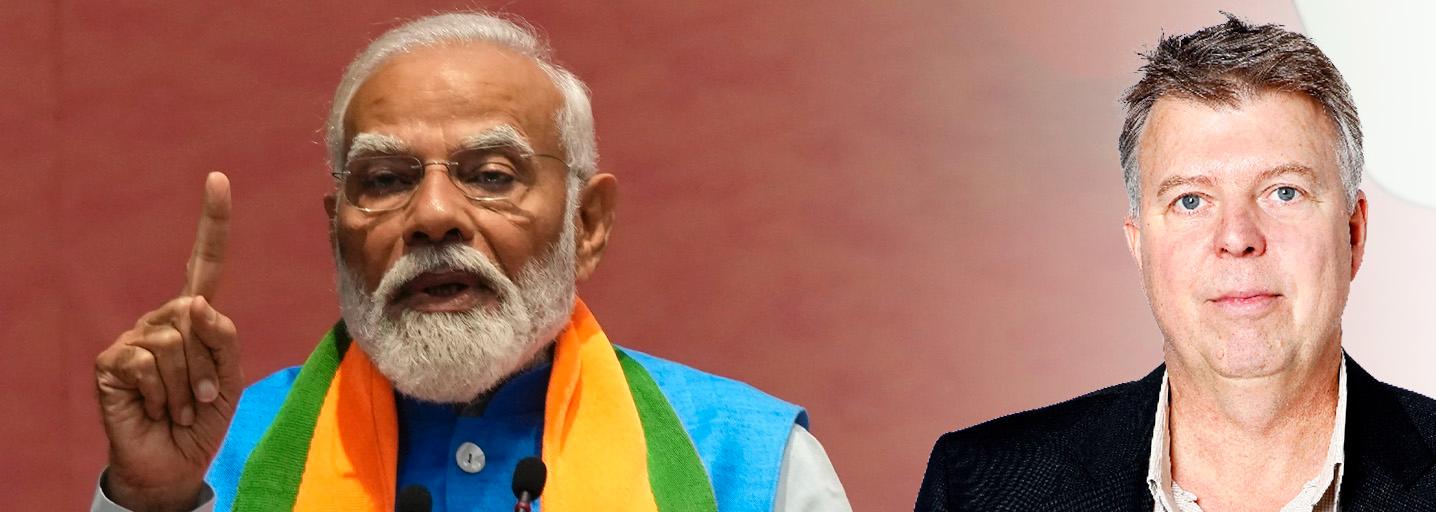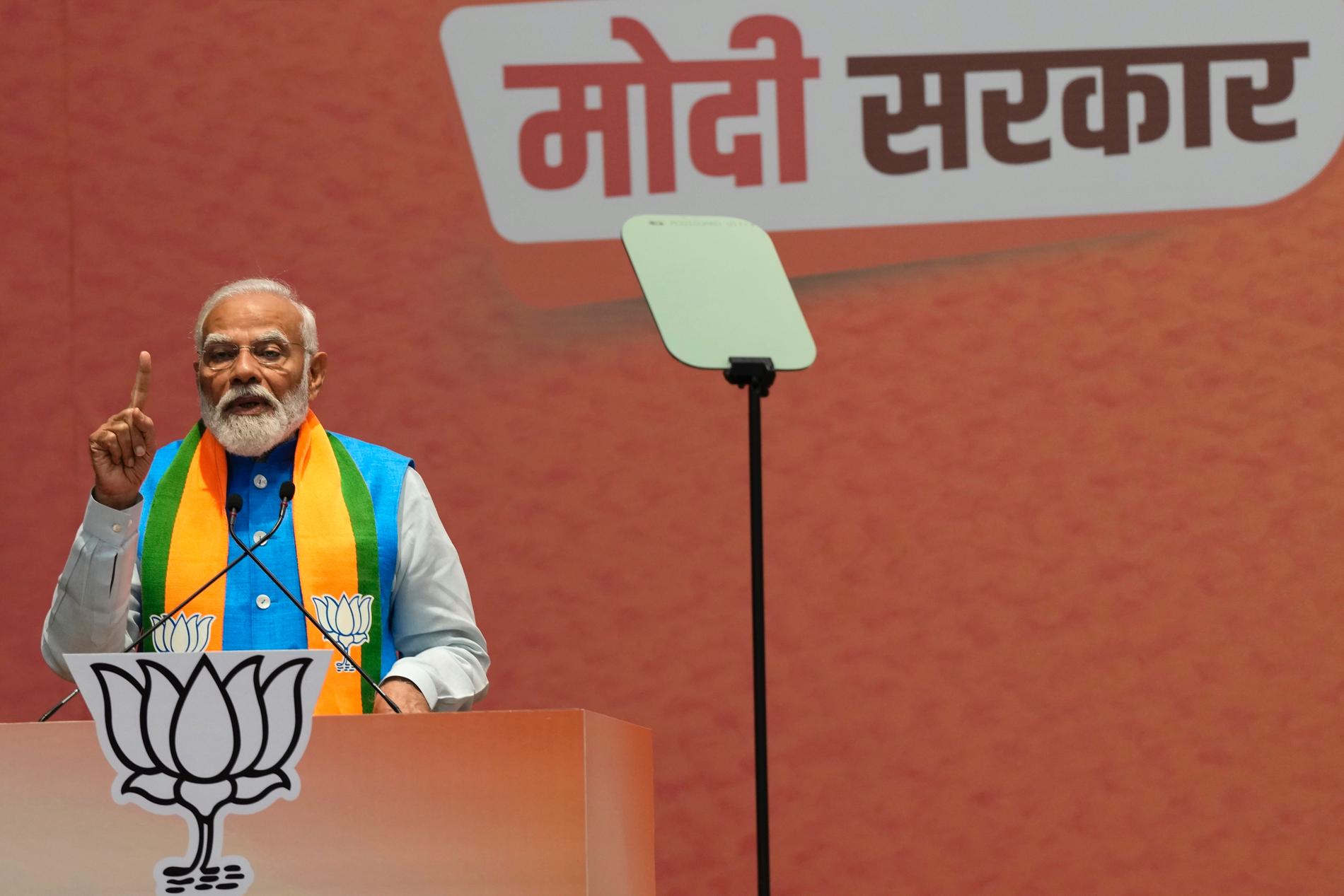
Narendra Modi
Modi dabbles with AI - while throwing critics in jail
Wolfgang Hansson
This is a commenting text. Analysis and positions are the writer's.
Published 08.29
India may not be the country one would expect to be among the first to use AI in an election campaign.
But now the voters have to face an avatar of Prime Minister Narendra Modi tipped for victory.
But while Modi, 73, is a modern leader who plays with AI, he is also an autocrat who jails the opposition and controls the media.
Quick version
- Indian Prime Minister Narendra Modi is using AI technology in his election campaign by using an avatar of himself to reach voters. While Modi is known for embracing modern technology, he also leads the country with an autocratic style, including restricting press freedom and harassing political rivals.
- Modi is also an advocate of Hindu nationalism, which is a controversial issue in religiously and ethnically diverse India. His policies have included laws discriminating against Muslims and the building of Hindu temples on sites where mosques once stood.
- Despite these challenges, Modi is leading in opinion polls ahead of the elections that run until June. His party's win would mean that India's democratic status continues to be called into question.
A bit in the same way that avatars of the pop group Abbas can perform almost daily in London's West End, even though none of them are on stage anymore.
Given that the elections in Indien, which started on April 19, will continue until the beginning of June, it is a smart way to try to reach as many of the giant country of India's almost one billion eligible voters as possible.
Modi's conservative party BJP has also developed a special app where the party keeps in touch with its sympathizers while collecting a lot of important data about the voter base.
Just like India as a nation, Narendra Modi despite his age is good at embracing modern technology. As far from senior surfers as you can get.
Modi is something of a dual nature. Because while he masters the new age's way of communicating, he is in many ways a backward seeker.
While his predecessors from the Gandhi dynasty ensured that India became a secular state where all religions were treated equally, Modi's main hallmark is the resurgence of Hindu nationalism.
It shows in many ways.

Modi, 73. Photo: Manish Swarup / AP
Law against Muslims
Recently, a law was introduced that excludes Muslims, the country's largest minority, from becoming citizens if they entered the country illegally. However, exceptions are made for a number of other religious minorities.
In January, Modi inaugurated a Hindu temple built on the site of a famous mosque that was demolished.
India was for a long time a country which, despite its poverty, had a free and highly active press.
But Modi does not like criticism. He has taken an increasingly tight grip on what newspapers write and television broadcasts by not allowing government institutions to advertise in Modi-critical media. Unsavory journalists are imprisoned on a loose basis.
He likes foreign media even less. Most have had their visa applications rejected to cover the elections in India. Reporting from Muslim-dominated Kashmir is completely prohibited for foreign reporters.
The Freedom House organization ranks India 161st in terms of freedom of the press.
The democracy organization International IDEA's four categories for measuring democracy all show declining curves from now and ten years ago.
India is still a democracy in the sense that people get to vote and the votes are counted properly. But Modi likes to use government agencies to harass politicians who in any way criticize or threaten his hold on power.
Recently, a law was introduced that excludes Muslims, the country's largest minority, from becoming citizens if they entered the country illegally. However, exceptions are made for a number of other religious minorities.
In January, Modi inaugurated a Hindu temple built on the site of a famous mosque that was demolished.
India was for a long time a country which, despite its poverty, had a free and highly active press.
But Modi does not like criticism. He has taken an increasingly tight grip on what newspapers write and television broadcasts by not allowing government institutions to advertise in Modi-critical media. Unsavory journalists are imprisoned on a loose basis.
He likes foreign media even less. Most have had their visa applications rejected to cover the elections in India. Reporting from Muslim-dominated Kashmir is completely prohibited for foreign reporters.
The Freedom House organization ranks India 161st in terms of freedom of the press.
The democracy organization International IDEA's four categories for measuring democracy all show declining curves from now and ten years ago.
India is still a democracy in the sense that people get to vote and the votes are counted properly. But Modi likes to use government agencies to harass politicians who in any way criticize or threaten his hold on power.

Modi during his election campaign earlier in April. Photo: AP
Rise out of poverty
As recently as last month, the government froze the bank accounts of the Congress party, one of the main contenders, on allegations that they had not paid their taxes.
Modi has also increased his control over the country's courts.
Everything according to the same recipe that we have previously seen used in, for example, Turkey, Hungary and Russia.
Against that stands the image of the giant country that is about to rise from poverty and poverty.
Modi's ten years in power have been marked by many strides in eradicating poverty and modernizing India's economy. The image many people have on their retinas of poor people herding sacred cows is no longer true. Today, India is so much more. Among other things, a high tech nation.
India is also rapidly becoming a major power. Not yet on par with China but heading in the same direction.
As recently as last month, the government froze the bank accounts of the Congress party, one of the main contenders, on allegations that they had not paid their taxes.
Modi has also increased his control over the country's courts.
Everything according to the same recipe that we have previously seen used in, for example, Turkey, Hungary and Russia.
Against that stands the image of the giant country that is about to rise from poverty and poverty.
Modi's ten years in power have been marked by many strides in eradicating poverty and modernizing India's economy. The image many people have on their retinas of poor people herding sacred cows is no longer true. Today, India is so much more. Among other things, a high tech nation.
India is also rapidly becoming a major power. Not yet on par with China but heading in the same direction.
ream seat
In many ways, Modi has a dream seat.
The US wants to be friends with India to counter China's influence in the region. The relationship has been upgraded with the cooperation that takes place within The Quad, where India, the USA, Australia and Japan mainly discuss security policy issues. Previously, it was diplomats who managed the dialogue. Nowadays it happens at the highest management level.
Despite that cooperation, Modi has sharply increased India's purchases of Russian oil, which he receives at bargain prices. Well aware that the US will not punish him or India for that.
Modi approaches the election with the same grounded confidence. He clearly leads in the opinion polls. Everything is about his BJP getting its own majority in Parliament.
When the results of the election report a few days into June, anything but a landslide victory for Modi will be a sensation.
In many ways, Modi has a dream seat.
The US wants to be friends with India to counter China's influence in the region. The relationship has been upgraded with the cooperation that takes place within The Quad, where India, the USA, Australia and Japan mainly discuss security policy issues. Previously, it was diplomats who managed the dialogue. Nowadays it happens at the highest management level.
Despite that cooperation, Modi has sharply increased India's purchases of Russian oil, which he receives at bargain prices. Well aware that the US will not punish him or India for that.
Modi approaches the election with the same grounded confidence. He clearly leads in the opinion polls. Everything is about his BJP getting its own majority in Parliament.
When the results of the election report a few days into June, anything but a landslide victory for Modi will be a sensation.
Inga kommentarer:
Skicka en kommentar